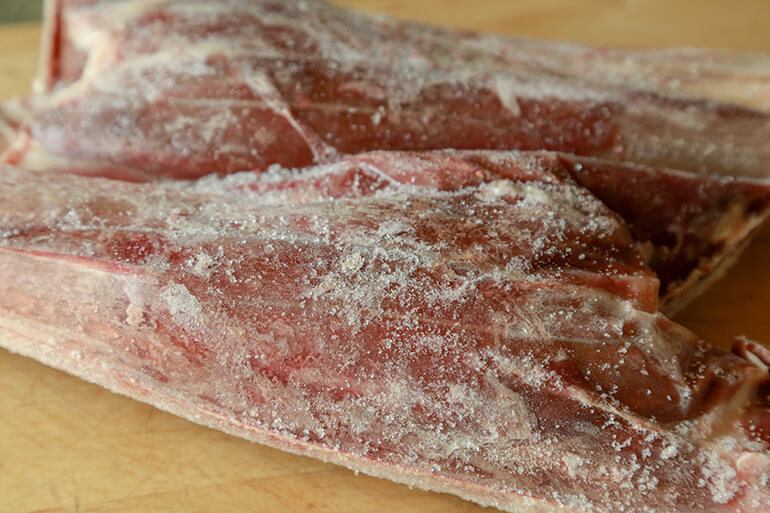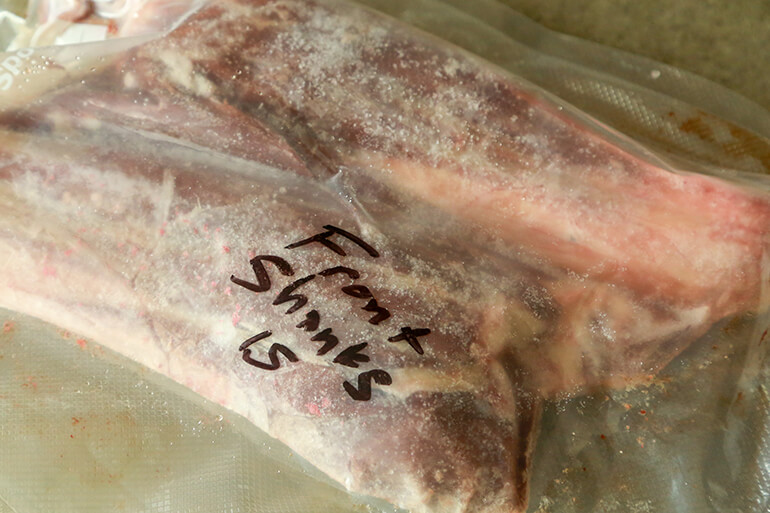
Print Recipe
Freezer burn accounts for a large proportion of food waste in U.S. homes, and as hunters, losing hard-earned wild game to freezer burn seems to sting a lot more. There is no disappointment like pulling venison backstrap from the freezer and finding it shriveled and covered in ice crystals. You haven’t thawed it, and yet you know the results will be heartbreaking. What happened?
What is freezer burn?
Freezer burn occurs when meat is exposed to air, most often due to poor packaging. When exposed to a freezer’s cold and dry air, moisture from inside the meat has a tendency to evaporate by sublimation. This causes dehydration, which changes the texture of steak from juicy and tender to dry and leathery.
See any frost on the inside walls of your freezer? That’s moisture that escaped from your food.
The exposure to oxygen also changes the color of meat from red to brown, which can affect taste.
What happens during freezer burn?
Have you noticed that pool of watery, pink liquid leaking from a bag of ground venison or thawed steak?
This liquid is a combination of water and a protein called myoglobin— not blood as people often believe. When a piece of steak tastes “juicy,” this liquid is responsible for that sensation. So therefore, to achieve the juiciest meat possible, you need to preserve as much of this liquid inside the muscle as possible.
Alton Brown explained freezer burn this way on an episode of Good Eats:
When meat freezes, water molecules inside the meat turn into ice crystals. The faster the food freezes, the smaller the crystals. The slower the food freezes, the bigger and more jagged the crystals. The problem is home freezers aren’t cold enough to flash freeze meats—they freeze food slowly, which results in larger ice crystals.
When ice crystals form, they act like daggers, which bruise and pop muscle cells, thus releasing water and myglobin. The bigger and more jagged the “daggers,” the more leaking there will be, thus the less juicy your meat will taste.
This, along with the combination of poor packaging and exposure to a freezer’s cold, dry air, sublimation will draw out moisture from meat faster. Large ice crystals form on the surface as moisture moves from the inside to the outside of meat, further degrading texture.
Slow Down Freezer Burn
Freezers were never meant to preserve meat indefinitely, which is why the USDA recommends consuming frozen meat within four months of freezing. For hunters who need their meat to stretch until next hunting season, a vacuum sealer is an indispensable tool. Good packaging can slow down the inevitable process of freezer burn for as long as three years.
A proper vacuum-sealed package keeps air out and keeps moisture inside the meat. By eliminating air pockets in the packaging and creating a tightly sealed barrier around the surface of meat, sublimation slows down drastically.

But remember that vacuum-sealed bags do degrade over time. They may lose their seal and invite oxygen. Check your frozen meats periodically. If there are signs of a bad seal, such as air pockets and/or the presence of ice crystals, open up the bag and vacuum seal the meat again while it’s still frozen. Then try to use that meat sooner rather than later.
Vacuum sealers also lose their ability to vacuum and seal properly. Depending on the brand, you will need to replace your vacuum sealer every few years.
Lastly, set your freezer to the lowest temperature possible. As discussed previously, freezing meat faster is preferable to freezing meat slower, which creates smaller ice crystals rather than big, jagged ones that can puncture muscle cells and release moisture.

Can I salvage freezer burned meat?
Freezer burn should be avoided, but the good news is that the meat is still safe to eat.
Small freezer-burned areas can be trimmed off. For more extensive freezer burns, the meat will usually taste OK slow cooked in soup or stew. If the whole thing looks like jerky you wouldn’t eat, it might be a better snack for your dog.
Again, freezer burn is inevitable. Meat cannot be kept frozen for years on end. That’s why it’s important to use your wild game in a reasonable, timely manner. Not only does this allow you to enjoy wild game at the peak of freshness, but you’re also making room in your freezer for next hunting season.











































